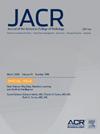ACR 适当性标准® 多胎妊娠:2024 年更新版。
IF 4
3区 医学
Q1 RADIOLOGY, NUCLEAR MEDICINE & MEDICAL IMAGING
引用次数: 0
摘要
双胎妊娠的发生率一直在上升,这主要归因于人工生殖技术的使用越来越多。超声检查在确定多胎妊娠的绒毛膜性和羊膜性方面起着至关重要的作用,是预测预期风险和并发症的关键因素,同时还能指导未来的临床和影像学随访检查及间隔时间。与单胎妊娠相比,多胎妊娠患者通常需要接受更多的超声波检查(偶尔也会进行胎儿核磁共振成像),至少包括妊娠头三个月的日期扫描、11 至 14 周的颈部透明层扫描、18 至 22 周的解剖扫描,以及妊娠第二和第三季度的其他扫描,以了解胎儿的生长发育情况并进行监测。本文件阐明了七种临床情况/变异中最合适的多胎妊娠影像学指南,包括无并发症多胎妊娠的初始影像学检查、随访影像学检查、生长发育和监测,以及因已知异常或胎儿间不一致而复杂化的多胎妊娠影像学检查。美国放射学会适宜性标准是针对特定临床情况的循证指南,每年由一个多学科专家小组进行审查。指南的制定和修订过程支持对来自同行评审期刊的医学文献进行系统分析。已确立的方法原则,如 "建议评估、发展和评价分级"(GRADE),被用来评估证据。兰德/加州大学洛杉矶分校《适宜性方法用户手册》提供了确定特定临床情况下成像和治疗程序适宜性的方法。在缺乏同行评议文献或文献模棱两可的情况下,专家可能是制定建议的主要证据来源。本文章由计算机程序翻译,如有差异,请以英文原文为准。
ACR Appropriateness Criteria® Multiple Gestations: 2024 Update
The incidence of twin pregnancies has been rising, largely attributable to increasing use of artificial reproductive techniques. Ultrasound plays a critical role in establishing the chorionicity and amnionicity of multiple gestations, a key predictor of the expected risk and complications, along with guiding future clinical and imaging follow-up examinations and intervals. People carrying multiple gestations will typically undergo more ultrasound examinations (and occasionally fetal MRI) than those carrying singletons, at minimum including a first trimester dating scan, nuchal translucency scan at 11 to 14 weeks, an anatomy scan at 18 to 22 weeks, and other scans in the second and third trimesters for growth and surveillance. This document clarifies the most appropriate imaging guidelines for multiple gestations for seven clinical scenarios/variants, which range from initial imaging, follow-up imaging, growth and surveillance for uncomplicated multiple gestations, and those complicated by a known abnormality or discordance between fetuses.
The American College of Radiology Appropriateness Criteria are evidence-based guidelines for specific clinical conditions that are reviewed annually by a multidisciplinary expert panel. The guideline development and revision process support the systematic analysis of the medical literature from peer reviewed journals. Established methodology principles such as Grading of Recommendations Assessment, Development, and Evaluation or GRADE are adapted to evaluate the evidence. The RAND/UCLA Appropriateness Method User Manual provides the methodology to determine the appropriateness of imaging and treatment procedures for specific clinical scenarios. In those instances where peer reviewed literature is lacking or equivocal, experts may be the primary evidentiary source available to formulate a recommendation.
求助全文
通过发布文献求助,成功后即可免费获取论文全文。
去求助
来源期刊

Journal of the American College of Radiology
RADIOLOGY, NUCLEAR MEDICINE & MEDICAL IMAGING-
CiteScore
6.30
自引率
8.90%
发文量
312
审稿时长
34 days
期刊介绍:
The official journal of the American College of Radiology, JACR informs its readers of timely, pertinent, and important topics affecting the practice of diagnostic radiologists, interventional radiologists, medical physicists, and radiation oncologists. In so doing, JACR improves their practices and helps optimize their role in the health care system. By providing a forum for informative, well-written articles on health policy, clinical practice, practice management, data science, and education, JACR engages readers in a dialogue that ultimately benefits patient care.
 求助内容:
求助内容: 应助结果提醒方式:
应助结果提醒方式:


